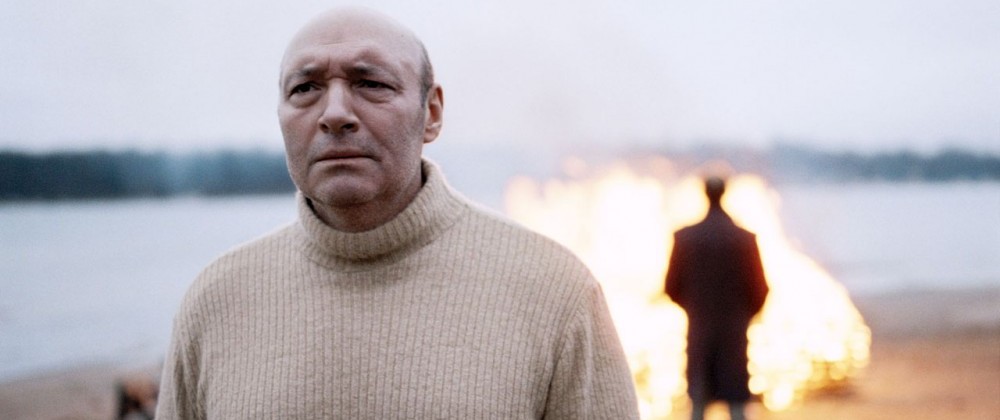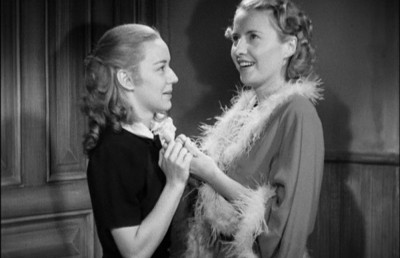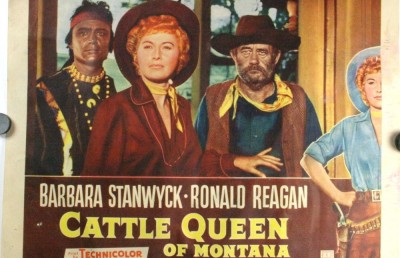Love, Friendship, Death, Grief, and Absurdity: Silent Souls, directed by Aleksei Fedorchenko
Traditions, old and new, reveal and obscure human impulses

Silent Souls
Director Aleksei Fedorchenko
Screenplay by Denis Osokin
Based on the novel Ovsyanki by Aist Sergeyev
Starring Igor Sergeyev, Yuri Tsurilo,
Yuliya Aug, Ivan Tushin
Produced by Igor Mishin, Mary Nazari
Zeitgeist Films/Shadow, 2010
Silent Souls, the quietly dramatic Russian film focused on two men conducting funeral rituals for the newly dead wife of one of the men, is film with a dark melancholy beauty—blue, gray, tan and brown seem to be its principal colors—and it has a contemplative and sensually alert and passionate narrative, a poetic narrative encompassing the spoken dialogue between the two men and also one man’s thoughts. The husband, a paper mill director, with the attendance of his friend, a paper mill photographer and a developing writer, cleans the wife’s body and the two then dress her most private part in the custom of the Merya people, a dead woman’s body being adorned similar to that of a bride. The men collect wood for a funeral pyre and travel to the town where the couple spent their honeymoon, and settle on a beach for the last rite. Although not much is known about the customs of Merya people, a Finnish-Ugric group living in the area of Moscow, there is record of the existence of the Merya people going back to the sixth century, and while many people thought they were integrated into the populations of Slavs and Russians by the time of the European middle ages, there is evidence that the Merya spoken language was still in use in the early nineteenth century; and the Merya are considered part of the foundation of Russia. Silent Souls is a film that pays attention to the elemental aspects of existence and culture, and suggests a power that outlasts the confinements of circumstance, place, and time.
Aleksei Fedorchenko, a Russian man and artist who, according to reports, studied engineering and economics and graduated from the Ural Polytechnical Institute and studied drama at the Russian National Film Institute, the director of First on the Moon, a fantasy-satire of a 1930s Soviet moon landing, has focused in the past on motion picture documentaries; and one can see that focus in the mundane facts of life in his film Silent Souls. “Populated by memories and dappled with desire, Silent Souls is part folk tale, part lesson in letting go. In its quiet acceptance of the passing of time, this unusual film reminds us that to die is not always the same as to disappear,” wrote a New York Times reviewer, Jeannette Catsoulis, September 15, 2011. The Silent Souls story, in which love is more important than the divine, is told by a man who should not have the authority or even ability to speak of this most private experience, a man without a provable place in the world. It is the kind of film that is not for every taste; and it has been called beautiful, inert, stunning, pretentious, laconic, provincial, chilling and rigorous by Variety’s Leslie Felperin (September 4, 2010), a response that seems rooted in the clash of aesthetic and commercial concerns. It is “a special film for special tastes,” conforms Deborah Young of the Hollywood Reporter (October 14, 2010). At Spirituality & Practice, about the time of the film’s release, Frederic and Mary Brussat wrote that Silent Souls “boldly takes on a subject that many are afraid to face: the strange brew of feelings, memories, and disappointments that are part and parcel of the grieving process. Aist serves as narrator of the drama and provides a near perfect role model of what it means to just be fully present with someone who is mourning the loss of a loved one.”
Aleksei Fedorchenko’s film Silent Souls, with the contributions of cinematographer Mikhail Krichman and production designer Aleksei Potapov, with editing by Sergey Ivanov, begins with a man on a bike, Aist (Igor Sergeyev), with a cage of two birds, buntings, comparable to finches and sparrows, on the bike at his back, riding on a rain-soaked paved road through a forest. It seems a long ride, before Aist crosses a floating bridge across the Neya river to arrive at his weather-beaten house. Aist, an ordinary looking man in early middle age, solitary, describes wanting to understand his people, the descendants of the Merya tribe, a Finnish group; a people whose demeanor tends to withhold their strong feelings. When Aist is asked by the paper mill director, Miron (Yuri Tsurilo), for help in preparing and transporting his newly dead wife’s body for the last rites, Aist has an opportunity to both participate in a tradition and, tragically, transcendently, to become one with it. In Neya at the paper mill, on a gray cloudy day Miron and Aist drink shadberry wine while Miron tells Aist that Miron wants no one else to see his wife and wants Aist’s help; and, as the trip may take days, Aist brings his birds, the buntings, with him.
The bike and the weather-beaten house suggest that the photographer and writer Aist does not have or spend money on modernization or appearances. Mostly simple things are his—and yet he does have a small computer for the writing he does. (Aist recalls that his self-taught but published poet father told Aist that when Aist was sad he should write then about the things around him.) Aist’s desire to understand his people, the Merya, is the typical wish of a poet or thinker; and it may be the kind of thing that only someone who is alienated, distant, from others would think of. Most people assume the habits of culture, performing them, rather than analyzing them. Aist is alone—he has no wife or children; and his newly acquired birds may be one response to that. Aist, for more than one reason, may be the natural candidate to take time away from his own life and work to go with Miron.
The deceased wife’s name is Tanya (Yuliya Aug); and she is a voluptuous woman, plain and plump with a simple beauty, and the preparation of her breathless body is solemn. Tanya seems to have the most perfect and real round breasts, like something out of a great painting. Her body is washed by her husband Miron, and, similarly to the way bridesmaids do before a wedding, Miron and Aist weave threads of beads through the woman’s pubic hair. (If it were a wedding, the husband would take off the threads, tie them in a knot, and hang the knot from an alder tree.) It is one of the traditions that has lasted but may be lost with greater modernity. The customs seem odd. Are they genuine? The online journal Kinokultura has named them the “entirely invented customs of the Merja people,” Merja being an alternative spelling of Merya (in a Kinokultura article attributed to Serguei Alex, 2011). Apparently, the film director Aleksei Fedorchenko has admitted in interview that he invented the customs. Does it matter if traditions are old or new? Do traditions, evolved or invented, illuminate and guide, or obscure? Once the body is prepared in Silent Souls, it is bundled in a colorful blanket, and the two men, with the body, leave Neya for Gorbatov, Miron’s car driving under a gray sky, brown grass on each side of the road.
Miron did not want anyone else to see his wife’s naked dead body, travel with him, or to help with the funeral. The body that Miron had desired, that was seen with love and lust, is treated at last with a reverent regard. Aist can be trusted to think and act properly; and to be a witness to the husband’s devoted attentions. Aist, as someone who appreciates the old ways, will not think of the customs as ignorance or superstition, but as a part of a significant heritage. To learn about a heritage or history, broad records and intimate portraits can be perused, statistics gathered and examined, and particular questions addressed. Sometimes familiarity with radical critiques can be helpful in clarifying the mind, whether or not one accepts their premises; but direct observation, with recourse to one’s own imagination and sensitivity, can be very helpful too. What is better than alert participation? In Silent Souls, the memory of the joy of a wedding is matched with the mourning at a spouse’s death, with similarities between the preparation of the presentation of the live bride and the dead wife; a circle has been completed. The film itself, Silent Souls, by the Siberia-born Aleksei Fedorchenko, a trained engineer for space defense projects who became production manager of the Sverdlovsk documentary studio and responsible for more than eighty films, appears to be a cinematic record of tradition. Is it; or is that merely the suggestion its aesthetic style?
The film’s beauty, like that of the wife, is simple, elemental: it is rooted in the creation of a sense of friendship and love, and the respect expressed and transgressed in the presence of death. Its beauty is perceptible in the scenes of ordinary nature, the sky, ground, grass, and water. As Miron drives the car with Aist next to him, and his blanketed dead wife in the back seat, Miron talks about his wife in a celebratory, intimate, sexual way, a traditional way of speaking at a spouse’s death, a way of transforming grief into tenderness, as Aist thinks. It turns out her nickname was Bunting, the name Miron called her in private, as her maiden name had been Buntinkina—a connection with Aist and his birds.
Sex is both complex and simple: an act of instinct and pleasure and love and procreation, animal and human, personal and social, existential and purposeful; and experience can make it exciting and inventive or a dull routine, as can the absence or presence of thought—with sex expressing or withholding who we are. Miron and Tanya could not have children together but sex for them remained an act of power—of desire and trust and love. Miron’s description of his erotic fascination and command of his wife is an affirmation of his own strength and feeling, and a way of keeping his wife alive in his mind, and an expansion of his relation to Aist. Memory is a way of making death meaningful, and a way of transcending death. At least that is one way of hearing or reading the sexual talk. Another interpretation is to understand it as a male indulgence, comic, intrusive, gratifying, a way of transgressing the usual boundaries of decorum and privacy. What is it that you want to know about the sex lives of others but have too much decency or fear to ask? What is it that you want to say about your own sexuality but know other people will not be inclined to hear? What are the things—facts, ideas, or kinds of speech—that an artist might want to present despite social taboos?
In Silent Souls, the men, Miron (Yuri Tsurilo) and Aist (Igor Sergeyev), stop at a hardware store—with blue walls and a tan floor—and buy wood, kindling, before continuing their trip, with Miron going through more of his memories: Miron recalls a concert attended with his wife Tanya (Yuliya Aug), when Miron was paid tribute with a piece of music by the performing group but was aroused by his feeling for his wife, but she restrained herself from gratifying him. It was a time when sex, the personal, the wild, attempted to subvert the social, the orderly—and though frustrated then, Miron, his adoration and his hunger, would be gratified later in private. Miron would bathe Tanya in vodka, using it like water. Tanya’s death seems to have been a strange surprise. Tanya, who was decades younger than Miron, had worked in the paper mill as did Miron and Aist, and Tanya liked Aist and Aist found her attractive, though nothing romantic happened between them—and that may be why Miron asked Aist for his help.
The two men might have been rivals, but as whatever attraction that had existed between Tanya and Aist had never been acted on, decorum and trust were preserved—and a common care can be assumed: Miron will not be the only mourner. In that way, two people whose personal feelings might have put them in opposition have reason and cause to be compatriots of the spirit in a difficult time, with the death of one man’s wife, the preparation of the body, and its burning. (Kinokultura has named two other Russian films, The Lover and How I Ended This Summer, as two films that have used a woman’s death as an opportunity for a rather hopeless male bonding.) It is easy to forget that the burning of the human body at death used to be more of an established tradition; and the film Silent Souls reminds us of that, with the funeral pyre built on the beach, the pouring of drinks on the bundled body, and the burning of the body. The ashes of the fire are poured into the sea, and the husband Miron throws into the water his wedding ring. Aist thinks of how water is special to the Merya people; and that drowning is considered a blessed death. Aist recalls his father burying his typewriter in the white ice of the Volga river—Volga is a genuine Merya word for white; and Aist recalls the two males, father and son, riding in a small boat to perform a funeral rite for Aist’s mother, who died in childbirth when Aist was a boy (with Ivan Tushin as young Aist). The memory of Aist’s youth—of his parents, of his father’s literary vocation and advice, of his mother’s death—makes this also Aist’s story; and it confirms the cultural tradition of the Merya people as asserted by the film, an ancient and once important Finnish-Ugric people who lived in the area of Moscow and Jaroslavl, Kostroma, Rostov and Vladimir, a people with its own language and religion, including sacred forests and stones, a people who were absorbed by Slavs and Russians.
Leaving, following the burning of Tanya’s body and the dissemination of her ashes, the two men, Miron and Aist, get lost and find themselves in an abandoned town, Molochai, which once had been a special place. They go further and visit a large department store, and subsequently meet two women, Julia and Rima, attractive and warm, one chesty and one flat, women with whom the men have intercourse. It is one of the most imaginative and simultaneously one of the simplest sex scenes I ever have seen: two naked women side by side on a blanket, without men, pantomiming sex as if men were there. There is then a gorgeous montage—nude bodies, a seated male body, a standing female body, on different sides of a room, with an image of traffic between them, the lights of cars on a highway passing between them. The traffic embodies society, ongoing life, distance and movement. Sex has been an interlude. Aist is grateful for the women, thinking that a live woman’s body is a river that carries away grief. Yet, the grief returns full force when Aist asks Miron if he imagines he will be with Tanya again. Is there reunion in death? Aist’s question opens Miron’s heart and it opens the door into another realm: birds fly, water beckons, and the direction of the trip changes, becomes fatal and final.
Often, for artists and thinkers, the gathering of old knowledge is the ground for the sprouting of new insight, just as in ordinary society the observance of certain traditional rituals of mourning allows for the closure of part of one aspect of a life and the beginning of the next. In Silent Souls, when Miron and Aist are on their way back to Neya, having completed funerary duties, Aist’s birds get free—there is no evidence that Aist frees them, contrary to the Kinokultura assertion—and the birds erupt in motion and noise, swiftly distracting the driver, and diverting the path of the car, which tumbles off the bridge into the river, into the water that Aist has thought special. “At 75 minutes, Silent Souls has the sustained flow of a musical composition. Past and present are seamless. The conviction is so strong that it only gradually becomes apparent that we are watching a posthumous tale, narrated by Aist from somewhere beyond the grave,” wrote The Village Voice’s J. Hoberman (September 14, 2011). Indeed, despite the film’s early announcement that Miron and Aist would not return to Neya, where their trip began, the ending of the film is still a shock. The film viewer may not know how to take it—and whether to accept it. Does the end nullify all that has come before? Is it a cosmic joke? Or does it affirm a belief in life after death, the ability of dead souls to speak to the living? Pop Matter’s critic Luke Taylor gives laudable attention to the realistic style of the film—using long takes and deep focus, and influenced by Welles, Rossellini, Godard, and Eisenstein—but Luke Taylor, commenting years after the film’s original release (February 28, 2013), does not examine or question how much reality the film is intended to contain. Taylor does not question the veracity of the film’s tribal customs or of the testimony given after death. However, there are many films and literature that put forth the idea that the dead can talk still; and where this used to have a certain charm, a strange but welcomed power, it begins to seem sentimental or absurd when it occurs as often as it does. It is hard not to wonder whether the filmmaker is profound or merely playing at profundity, using his expert skill as a documentarian to achieve a new kind of mockery. How one receives the film may depend, finally, on one’s own sensibility. For me, it seems a genuinely beautiful and thoughtful and moving film, part of a familiar art house tradition—but its existence, its nature and the history of the director Aleksei Fedorchenko, does make one more watchful, more wary.
(Essay submitted April 12, 2013)













